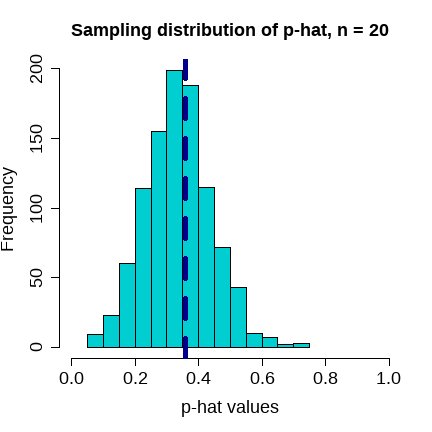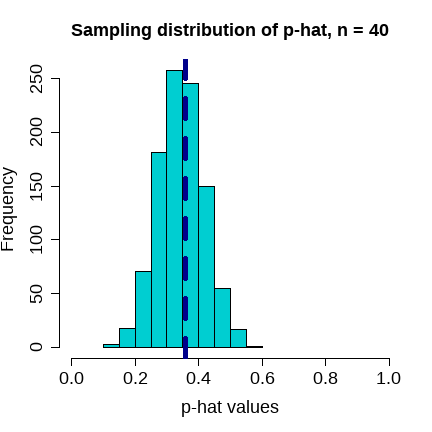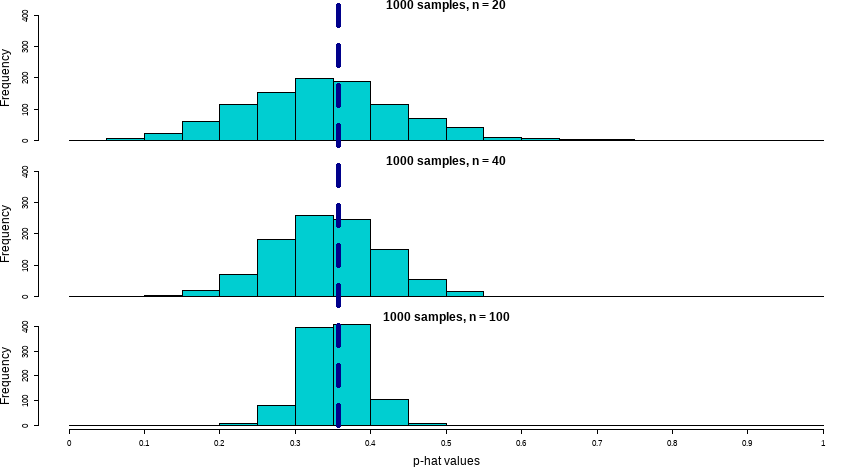class: center, middle, inverse, title-slide # STATS 250 Lab 08 ## Sampling Distributions of Proportions ### Nick Seewald<br />nseewald@umich.edu ### Week of 10/19/2020 --- class: center middle # Reminders 💡 Your tasks for the week running Friday 10/19 - Friday 10/23: | Task | Due Date | Submission | |:-----|:---------|:-----------| | Lab 8 | Friday 10/23 8:00AM ET | Canvas | | *No homework this week* | -- | course.work | Office hours are back to normal this week (with a few small tweaks) Midterm regrade requests through Gradescope due **Tuesday 10/27 8a --- class: center # Midterm Recap <img src="../../midtermDist.png" width=80% /> -- If the midterm didn't go as expected *that's OKAY*. There's plenty of semester left. --- # What's the plan? Today we're going to learn about "sampling distributions" and something called the **Central Limit Theorem** (CLT). -- The central limit theorem is sort of magical. We'll talk about it in more detail in lecture! <div style="text-align:center;"><img src=https://media.tenor.com/images/2450a453b34f80581db8ba53a650cf73/tenor.gif /></div> --- # Sampling Distributions A **sampling distribution** refers to the possible values for a *statistic* (e.g., `$$\hat{p}$$` ) and how often those values occur. We've sort of seen sampling distributions already. Can you think of how? -- The histograms we've made of `$$\hat{p}_{\mathrm{sim}}$$` are sampling distributions of `\(\hat{p}\)` (under the null hypothesis model)! --- class: inverse # Penguins! ```r penguins <- read.csv("https://raw.githubusercontent.com/STATS250SBI/palmerpenguins/master/inst/extdata/penguins_NArm.csv", stringsAsFactors = TRUE) ``` <div style="text-align:center;"><img src="https://raw.githubusercontent.com/STATS250SBI/palmerpenguins/master/man/figures/lter_penguins.png" width=700 /></div> --- class: inverse # Penguins! Let's remind ourselves of what variables are in this data: ```r # Use your favorite function or two to explore the data ``` -- ```r # Use your favorite function or two to explore the data names(penguins) ``` ``` [1] "species" "island" "bill_length_mm" [4] "bill_depth_mm" "flipper_length_mm" "body_mass_g" [7] "sex" "year" ``` -- > IMPORTANT NOTE: For the purposes of this example, we're going to assume that the penguins in the data represent the *population* of all penguins in the Palmer Archipelago. This is obviously not true: there are more than 333 penguins living on these islands. *This is just to illustrate ideas*. --- # "Population" proportions Assuming our data is on the full population of penguins in the archipelago, how could we find the population proportion of Gentoo penguins? -- ```r proportions(table(penguins$species)) ``` ``` Adelie Chinstrap Gentoo 0.4384384 0.2042042 0.3573574 ``` -- `$$p = 0.357$$` where `\(p\)` is the population proportion of Gentoo penguins in the Palmer Archipelago --- # `set.seed()` Start by setting the seed: ```r set.seed(7923) ``` Things to remember when setting the seed: - Guaranteed to get the same results from the same code in the *knitted* document - Determines the *sequence* of random numbers: things can get knocked off sequence - Use "Run All Chunks Above" to get back on sequence and to get the same numbers as in the knitted document --- # Taking a sample Take a sample of size 20 from the "population" of all penguins: ```r sample1 <- penguins[sample(1:333, size = 20), ] ``` -- ``` species island bill_length_mm bill_depth_mm flipper_length_mm body_mass_g 271 Chinstrap Dream 45.2 17.8 198 3950 252 Gentoo Biscoe 43.3 14.0 208 4575 sex year 271 female 2007 252 female 2009 ``` -- ```r proportions(table(sample1$species)) ``` ``` Adelie Chinstrap Gentoo 0.50 0.15 0.35 ``` --- # Taking *another* sample ```r sample2 <- penguins[sample(1:333, size = 20), ] # reusing the same code as above proportions(table(sample2$species)) ``` ``` Adelie Chinstrap Gentoo 0.65 0.20 0.15 ``` We get different results! This is expected, it's *sample-to-sample variability*. -- <div style="text-align:center;"><img src="https://media.tenor.com/images/06c9e89b2c9a326c66129ed438f23d62/tenor.gif" width=400 /></div> --- # 1000 more samples .pull-left[ ```r samplesOfSize20 <- replicate(1000, { s <- penguins[sample(1:333, size = 20), ] proportions(table(s$species))["Gentoo"] }) ``` ```r hist(samplesOfSize20, main = "Sampling distribution of p-hat, n = 20", xlab = "p-hat values", col = "darkturquoise", xlim = c(0, 1), cex.lab = 1.5, cex.main = 1.5, cex.axis = 1.5) abline(v = proportions(table(penguins$species))["Gentoo"], lwd = 5, lty = "dashed", col = "darkblue") ``` ] .pull-right[  ] --- class: center, middle, inverse # Describe this distribution ### https://pollev.com/nickseewald611  --- # Larger samples: `\(n = 40\)` .pull-left[ ```r samplesOfSize40 <- replicate(1000, { s <- penguins[sample(1:333, size = 40), ] proportions(table(s$species))["Gentoo"] }) ``` ```r hist(samplesOfSize40, main = "Sampling distribution of p-hat, n = 40", xlab = "p-hat values", col = "darkturquoise", xlim = c(0, 1), cex.lab = 1.5, cex.main = 1.5, cex.axis = 1.5) abline(v = proportions(table(penguins$species))["Gentoo"], lwd = 5, lty = "dashed", col = "darkblue") ``` ] .pull-right[  ] --- class: center, middle, inverse # How do these distributions compare? https://pollev.com/nickseewald611 .pull-left[  ] .pull-right[  ] --- # Even larger samples: `\(n = 100\)` .pull-left[ ```r samplesOfSize100 <- replicate(1000, { s <- penguins[sample(1:333, size = 100), ] proportions(table(s$species))["Gentoo"] }) ``` ```r hist(samplesOfSize100, main = "Sampling distribution of p-hat, n = 100", xlab = "p-hat values", col = "darkturquoise", xlim = c(0, 1), cex.lab = 1.5, cex.main = 1.5, cex.axis = 1.5) abline(v = proportions(table(penguins$species))["Gentoo"], lwd = 5, lty = "dashed", col = "darkblue") ``` ] .pull-right[  ] --- class:center # Comparing Results https://pollev.com/nickseewald611 <!-- --> --- # More Detail .pull-left[ <div style="text-align:center;"><img src="histgif/clt-proportions.gif" /></div> ] .pull-right[ As the size of our samples increases, the sampling distribution of `\(\hat{p}\)` becomes... 1. more obviously centered around `\(p\)` 1. narrower 1. more bell-shaped ] --- # Central Limit Theorem > If we look at a proportion (or difference in proportions) and the scenario satisfies certain conditions, then the sample proportion (or difference in proportions) will appear to follow a bell-shaped curve called the *normal distribution*. -- ##Conditions: 1. **Observations in the sample are independent.** Guaranteed by random sampling or random allocation to treatment/control. 1. **The sample is large enough.** "Large enough" means `\(n\times p \geq 10\)` *and* `\(n\times (1-p) \geq 10\)` ($p$ the *population* proportion). --- class: inverse # Lab Project ⌨️ .pull-left[ ### Your tasks - Complete the "Try It!" and "Dive Deeper" portions of the lab assignment by copy/pasting and modifying appropriate code from earlier in the document. - Introduce yourself to your collaborators - **Do not leave people behind.** ] .pull-right[ ### How to get help - Ask your collaborators -- share your screen! - Use the "Ask for Help" button to flag me down. ] --- class: center middle # Reminders 💡 ### http://bit.ly/250ticket8 Your tasks for the week running Friday 10/19 - Friday 10/23: | Task | Due Date | Submission | |:-----|:---------|:-----------| | Lab 8 | Friday 10/23 8:00AM ET | Canvas | | *No homework this week* | -- | course.work | Office hours are back to normal this week (with a few small tweaks) Midterm regrade requests through Gradescope due **Tuesday 10/27 8a